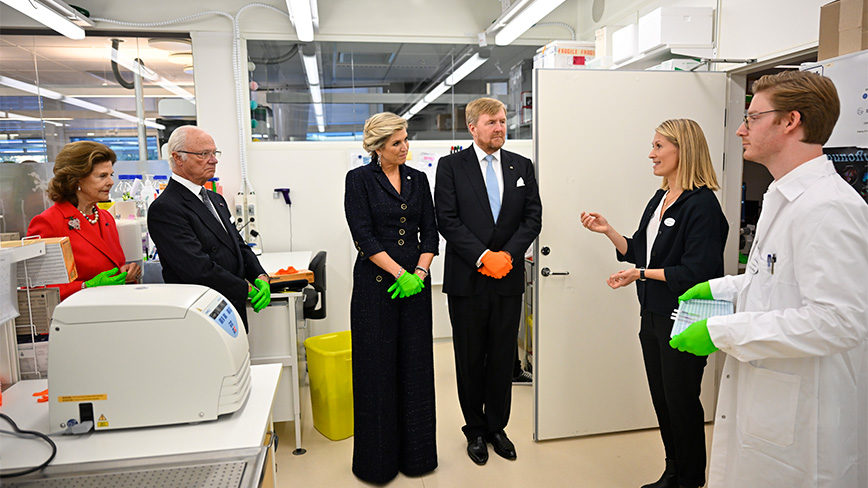Royal visit at SciLifeLab

On 12 October, the Swedish Royal couple visited the national research infrastructure SciLifeLab together with the King and Queen of the Netherlands, to learn more about technologies to study cells and initiatives for precision medicine. The visit was part of a state visit from the Netherlands for which life science is one of the key topics.
“Our research is a lot about gaining a deeper insight into the microenvironment of specific tumors to help in future treatment selection for each and every patient,” says Charlotte Stadler, Head of the Spatial Proteomics unit and co-Director of the Spatial and Single cell biology platform at SciLifeLab.
The purpose of the visit was to reaffirm and advance the excellent and long-standing relations between Sweden and the Netherlands, dating back to the 1600s. The countries are working together to make Europe greener, more resilient, and economically stronger. In addition to life sciences, the focus of the state visit was green innovation, maritime relations, and gender equality.
”It is a major recognition for SciLifeLab to be selected as a site for this state visit and it was our pleasure to guide these distinguished visitors through a glimpse of the vast research resources and infrastructure that SciLifeLab offers,” says Ylva Engström, Professor at Stockholm University, and Chair of the SciLifeLab board, in a press release.
Got to visit the lab
Precision medicine aims at a more individualized treatment, using a number of data points which today can be produced for each patient. First, the royalties listened to overall presentations from Mia Philipson, co-Director of SciLifeLab, and Päivi Östling, Scientific lead of the precision medicine initiative. Then, Charlotte Stadler hosted their Majesties in her lab where cutting edge instruments are used to generate highly multiplexed imaging data to decipher the tumor microenvironment of patient samples.
“We talked about our research and visions for modernizing pathology using these technologies we have at hand in our lab and we showed some concrete examples of images of different tissues and cells. The imaging technologies we use make it possible to detect more than 30 proteins in the same tissue sample. This allows us to get a much deeper insight into the tumor biology and help us identify prognostic factors such as cell type distributions and interactions that could play a role in how well a patient responds to a given therapy,” says Charlotte Stadler.
Important recognition
She thinks it is an important recognition for SciLifeLab and the molecular life science field that the royal couples chose to visit SciLifeLab as part of the three-day visit.
“We received many questions from the Swedish as well as from the Dutch royal couple. They seemed very engaged and interested, not least of our visions of taking these new technologies towards clinical practice as a way of modernizing how tumor diagnosis is done today within healthcare,” says Charlotte Stadler.
Text: Sabina Fabrizi
